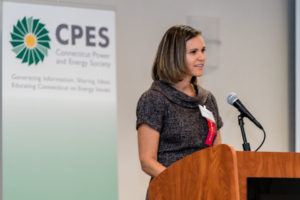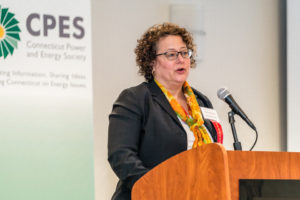
Wrap Up from
Wednesday, November 9, 2016: Courtyard Marriott, Cromwell.
Thank you to our Sponsor, Starion Energy.
On November 9, 2016, the Connecticut Power and Energy Society (CPES) heard from representatives of state government, the state’s largest electric distribution company, and the state’s largest electric generator on how Connecticut can address its ambitious greenhouse gas (GHG) reduction goals. Panelists included:

- Keri Enright-Kato, Director, Office of Climate Change, Technology & Research, Bureau of Energy and Technology Policy, Connecticut Department of Energy and Environmental Protection (DEEP)
- Tracy A. Gionfriddo, Senior Environmental Specialist, Environmental Compliance and Performance, Eversource Energy
- Kevin Hennessy, Director, State Policy – New England, Dominion Resources
 Keri Enright-Kato of DEEP discussed Connecticut’s efforts to combat climate change and reviewed the state’s GHG reduction goals found in the Global Warming Solution Act. Adopted by the General Assembly in 2008, the Global Warming Solutions Act sets forth the following GHG emission reduction requirements: (1) reduce GHG emissions to 10% below 1990 levels by January 2020; and (2) reduce GHG emissions to 80% below 2001 levels by January 2050. Enright-Kato reviewed the two accounting methods for measuring GHG emissions, including the generation-based approach and the consumption-based approach. The generation-based approach measures emissions from electric generating facilities in Connecticut while the consumption-based approach measures GHG emissions based on Connecticut’s share of electricity consumption in the region. Enright-Kato stated that transformational change would be needed to meet the state’s long-term GHG reduction goals and highlighted the work of the Governor’s Council on Climate Change (GC3) in achieving those goals. Created on Earth Day in 2015, GC3 is tasked with examining the effectiveness of existing policies and regulations designed to reduce GHG emissions and identify new strategies to meet the state’s GHG reduction target of 80% below 2001 levels by 2050.
Keri Enright-Kato of DEEP discussed Connecticut’s efforts to combat climate change and reviewed the state’s GHG reduction goals found in the Global Warming Solution Act. Adopted by the General Assembly in 2008, the Global Warming Solutions Act sets forth the following GHG emission reduction requirements: (1) reduce GHG emissions to 10% below 1990 levels by January 2020; and (2) reduce GHG emissions to 80% below 2001 levels by January 2050. Enright-Kato reviewed the two accounting methods for measuring GHG emissions, including the generation-based approach and the consumption-based approach. The generation-based approach measures emissions from electric generating facilities in Connecticut while the consumption-based approach measures GHG emissions based on Connecticut’s share of electricity consumption in the region. Enright-Kato stated that transformational change would be needed to meet the state’s long-term GHG reduction goals and highlighted the work of the Governor’s Council on Climate Change (GC3) in achieving those goals. Created on Earth Day in 2015, GC3 is tasked with examining the effectiveness of existing policies and regulations designed to reduce GHG emissions and identify new strategies to meet the state’s GHG reduction target of 80% below 2001 levels by 2050.
 Tracy Gionfriddo of Eversource discussed her company’s efforts to reduce GHG emissions across the New England region. Compared to its peers, Gionfriddo explained, Eversource has a small carbon footprint as an electric and gas delivery company. For that reason, Gionfriddo noted, Eversource began looking for ways to facilitate the reduction of GHG emissions beyond its own company footprint. Gionfriddo stated that Eversource has focused on programs that reduce the region’s carbon intensity, including energy-efficiency programs and renewable energy programs. Gionfriddo also mentioned Eversource’s efforts to bring additional supplies of carbon-free hydropower down from Eastern Canada to New England load centers through electric transmission infrastructure.
Tracy Gionfriddo of Eversource discussed her company’s efforts to reduce GHG emissions across the New England region. Compared to its peers, Gionfriddo explained, Eversource has a small carbon footprint as an electric and gas delivery company. For that reason, Gionfriddo noted, Eversource began looking for ways to facilitate the reduction of GHG emissions beyond its own company footprint. Gionfriddo stated that Eversource has focused on programs that reduce the region’s carbon intensity, including energy-efficiency programs and renewable energy programs. Gionfriddo also mentioned Eversource’s efforts to bring additional supplies of carbon-free hydropower down from Eastern Canada to New England load centers through electric transmission infrastructure.
 Kevin Hennessy of Dominion discussed the role of nuclear power in achieving the state’s and region’s GHG reduction goals. Dominion owns Millstone Nuclear Power Station, located in Waterford, Connecticut, one of three remaining nuclear facilities in New England. The other two facilities are Pilgrim Nuclear Power Station, located in Plymouth, Massachusetts, and Seabrook Nuclear Power Station, located in Seabrook, New Hampshire. Pilgrim Station has decided to retire its unit as of June 1, 2019. Hennessy discussed the market pressures facing nuclear units in New England, including the region’s flattening electricity demand and the prolific supply of low-cost shale gas putting downward pressure on wholesale electricity prices. Accounting for 90% of Connecticut’s carbon-free power and 40% of the region’s carbon-free power in 2015, Hennessy stressed that existing nuclear power is critical to Connecticut achieving its carbon reduction goals.
Kevin Hennessy of Dominion discussed the role of nuclear power in achieving the state’s and region’s GHG reduction goals. Dominion owns Millstone Nuclear Power Station, located in Waterford, Connecticut, one of three remaining nuclear facilities in New England. The other two facilities are Pilgrim Nuclear Power Station, located in Plymouth, Massachusetts, and Seabrook Nuclear Power Station, located in Seabrook, New Hampshire. Pilgrim Station has decided to retire its unit as of June 1, 2019. Hennessy discussed the market pressures facing nuclear units in New England, including the region’s flattening electricity demand and the prolific supply of low-cost shale gas putting downward pressure on wholesale electricity prices. Accounting for 90% of Connecticut’s carbon-free power and 40% of the region’s carbon-free power in 2015, Hennessy stressed that existing nuclear power is critical to Connecticut achieving its carbon reduction goals.
